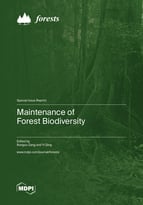Maintenance of Forest Biodiversity
A special issue of Forests (ISSN 1999-4907). This special issue belongs to the section "Forest Biodiversity".
Deadline for manuscript submissions: closed (28 February 2023) | Viewed by 33184
Special Issue Editors
Interests: biodiversity conservation; forest ecology; forest dynamics; vegetation ecology; forest management
Interests: forest restoration; community assemblage; biodiversity conservation
Special Issues, Collections and Topics in MDPI journals
Special Issue Information
Forests play the most dominant roles in maintaining biodiversity among terrestrial ecosystems and providing ecosystem functioning, such as nutrient cycle, carbon sequestration, and ecosystem stability. Over the past several decades, however, global forests are facing unprecedented pressure from climate change and anthropogenic disturbances, resulting in a high rate of biodiversity loss due to deforestation, fragmentation, and degradation. Determining how to maintain biodiversity is extremely urgent if we want to achieve the aims of the Convention on Biological Diversity (CBD) and the Sustainable Development Goals (SDGs). The complex structure, species interaction, heterogenic environment, and regional species pool all affect the spatial and temporal patterns of forest species, but it is still unclear how these effects maintain long-term forest biodiversity as forests are undergoing rapid variations in habitat features under global change. To improve our understanding of the underlying mechanism of forest biodiversity maintenance, we have launched this Special Issue to share findings related to species distribution pattern, species coexistence, community assembly, and above- and below-ground biotic interactions across different trophic levels in different forest types across varied spatial and temporal scales. All studies relevant to forest biodiversity maintenance are welcome.
Prof. Dr. Runguo Zang
Prof. Dr. Yi Ding
Guest Editors
Manuscript Submission Information
Manuscripts should be submitted online at www.mdpi.com by registering and logging in to this website. Once you are registered, click here to go to the submission form. Manuscripts can be submitted until the deadline. All submissions that pass pre-check are peer-reviewed. Accepted papers will be published continuously in the journal (as soon as accepted) and will be listed together on the special issue website. Research articles, review articles as well as short communications are invited. For planned papers, a title and short abstract (about 100 words) can be sent to the Editorial Office for announcement on this website.
Submitted manuscripts should not have been published previously, nor be under consideration for publication elsewhere (except conference proceedings papers). All manuscripts are thoroughly refereed through a single-blind peer-review process. A guide for authors and other relevant information for submission of manuscripts is available on the Instructions for Authors page. Forests is an international peer-reviewed open access monthly journal published by MDPI.
Please visit the Instructions for Authors page before submitting a manuscript. The Article Processing Charge (APC) for publication in this open access journal is 2600 CHF (Swiss Francs). Submitted papers should be well formatted and use good English. Authors may use MDPI's English editing service prior to publication or during author revisions.
Keywords
- above- and below-ground interactions
- community assemblage
- forest dynamic
- functional diversity
- natural forests
- species coexistence







